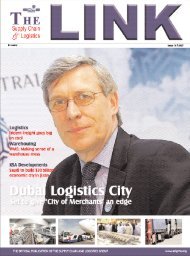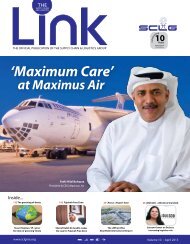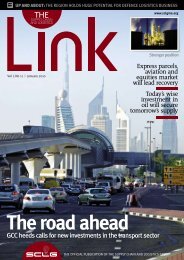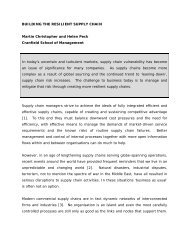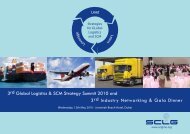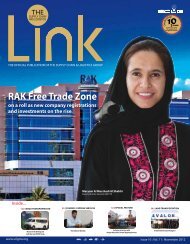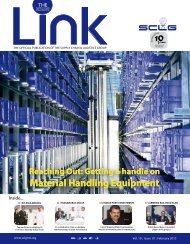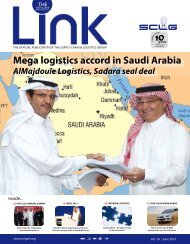Free to Download - SCLG
Free to Download - SCLG
Free to Download - SCLG
- TAGS
- download
- sclg
- sclgme.org
Create successful ePaper yourself
Turn your PDF publications into a flip-book with our unique Google optimized e-Paper software.
Understanding leadership<br />
I<br />
was walking alongside the river Danube<br />
I<br />
was walking alongside the river Danube<br />
in Budapest, Hungary late noon last<br />
month where the temperature was<br />
subzero when I received a call from Dr Ken,<br />
a researcher and professor of leadership,<br />
organizational design and behavior in USA<br />
who brought my attention <strong>to</strong> the subject<br />
of Leadership. “Leadership is mostly an<br />
organizational phenomenon and not solely<br />
the property of individuals”, said Dr Ken.<br />
Later I was engaged in several discussions<br />
with Dr Ken and other leading experts in the<br />
domain of organizational development and<br />
leadership over past weeks.<br />
During the course of such discussions<br />
many concepts and practical <strong>to</strong>ols relating<br />
processes, management, leadership, related<br />
competence & behavioral traits, related<br />
processes and technologies came <strong>to</strong> the fore<br />
which become an enabler for attaining high<br />
performance of organizational leadership.<br />
I was faced with some deep, some vague<br />
and some contrasting statements, a few are<br />
reproduced as below:<br />
Leaders are those who are bosses.<br />
Leadership is about influencing one<br />
in direction of desired contribution for<br />
something great <strong>to</strong> happen. Leadership<br />
is all about authority managers having <strong>to</strong><br />
take decisions and supervise. Discussions<br />
relating <strong>to</strong> organizational leadership has<br />
been centuries old with no definitive model<br />
till date. Leaders are born and common<br />
people cannot not be trained <strong>to</strong> be leaders.<br />
I was guided <strong>to</strong>wards 5 big traits (Openness,<br />
Conscientiousness, Extraversion,<br />
Agreeableness, Neuroticism) and develop<br />
them systematically for individuals <strong>to</strong><br />
attain leadership values. There are many<br />
personality assessment <strong>to</strong>ols like NEO-PI<br />
available <strong>to</strong> test leadership competence of<br />
human assets and help develop them.<br />
I am now more convinced that the way<br />
we devise organizations, deploy human<br />
resources & material resources in a welldefined<br />
horizontal and vertical hierarchy,<br />
continuously develop competence, acquire<br />
and recruit talent in more scientific ways has<br />
a positive and sometimes dramatic impact<br />
on organizational performance. So human<br />
resources and their continued development<br />
are as important as deployment of<br />
processes and technologies. I was then<br />
56 Link January 2011<br />
Think of simple questions and help<br />
prepare your organizations in identifying,<br />
acquiring, developing and leveraging<br />
human talents, managers and leaders,<br />
advises Shashi Shekhar, Founder &<br />
Group President<br />
<strong>to</strong>ld that many organizations in this region<br />
still had an opportunity <strong>to</strong> organize human<br />
resources functions more scientifically<br />
— there are many organizations in this<br />
region which don’t have a well defined<br />
human resources development efforts and<br />
dedicated personnel <strong>to</strong> drive such efforts. An<br />
attitude of ignorance <strong>to</strong>wards human assets<br />
development for leveraging their potential<br />
could be fatal <strong>to</strong> organizations in the post-<br />
recession period.<br />
Leadership and management are two<br />
notions that are often used interchangeably.<br />
These words actually describe two different<br />
manifestations of organizational behavior.<br />
Leadership is just one of the many assets a<br />
successful manager should possess. While<br />
managers focus <strong>to</strong> maximize the bot<strong>to</strong>m-line<br />
through administrative implementation of<br />
organization planning, staffing, directing and<br />
controlling, leaders bring sensitive and fairly<br />
radical thinking <strong>to</strong> these functions. Managers<br />
generally think incrementally while leaders<br />
think more radically.<br />
Leaders also generate more loyalty due<br />
<strong>to</strong> their attitude <strong>to</strong>wards ownership of failures<br />
and awarding credit of success <strong>to</strong> others<br />
involved. I subscribe <strong>to</strong> a view-point that<br />
managing and leading are two different ways<br />
of organizing manpower. The managers<br />
use a more formal, rational method whilst<br />
the leaders exhibit passion and emotion.<br />
William Wallace is one excellent example of<br />
a brilliant leader but could never be thought<br />
of as the manager of the Scots.<br />
Great leaders create great organizations.<br />
Great organizations deliver both social and<br />
economic values. So great organizations<br />
and great leaders are needed all the<br />
time. Organizations should follow an<br />
integrated approach <strong>to</strong> the development<br />
of human resources, related processes<br />
and technologies — many organizations<br />
in the region need <strong>to</strong> pay more importance<br />
in acquiring, retaining, engaging and<br />
organizing talents.<br />
While I am busy with this subject, I would<br />
encourage all <strong>to</strong> think of simple questions<br />
and help prepare your organizations in<br />
identifying, acquiring, developing and<br />
leveraging human talents, managers and<br />
leaders:<br />
Ë Are jobs and job holders in my<br />
organization mapped <strong>to</strong> competence.<br />
Ë Is my organization doing assessment<br />
of competence and traits for all employees,<br />
managers and leaders.<br />
Ë Have I, my peers and superiors ever<br />
undergone leadership and other personality<br />
assessment tests, if yes then what<br />
happened next.<br />
Ë Is my organization deploying process<br />
and technology framework for identifying and<br />
training high potential leaders.<br />
Ë Is my organization deploying process<br />
and technology for career and succession<br />
planning?<br />
Ë Is my organization doing non-partial<br />
performance evaluation and review and are<br />
such review processes mapped <strong>to</strong> rewards.<br />
Ë Are jobs linked <strong>to</strong> competence and are<br />
competence then assessed and developed.<br />
Hope the Year 2011 begins with more<br />
attention <strong>to</strong> human assets, managers and<br />
leaders – all are finally people.




